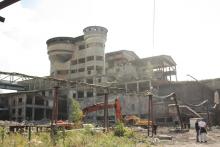STOP the demolition of Petrila Coal Mine's industrial heritage
Roemeense collegae vragen steun voor hun campagne tot behoud van de Petrila-steenkoolmijn. Het is een prachtige site die bedreigd is.
De uitbating van steenkool zorgde er voor dat Petrilla vanaf het midden van de 19de eeuw zich ontwikkelde als een stad en regio waarvan de welstand op maar één nijverheid gebaseerd was. De uitbating begin in 1840, en op het hoogtepunt, in 1984 werd er 1.255.240 ton bovengehaald, een cijfer dat nadien langzaam maar zeker zakte tot 504.000 ton/jaar.
De bevolking van de stad bleef relatief beperkt tot de vroegere Roemeense president, ten tijde van het communistisch regime, werkkrachten uit Moldavië naar hier deed migreren.
In de Petrila-mijn gebeurden verschillende ongelukken, o.m. in 2001 en op 15 November 2008. In dat laatste lieten 12 mijnwerkers het leven.
De steenkoolmijn zorgde niet alleen voor het levensonderhoud van stad en streek, maar lag ook een de basis van een collectieve identiteit. Als gevolg van het Europees beleid, waarbij verlieslatende steenkoolmijnen moeten sluiten, is ook het lot van de Petrila-mijn (en dat van twee andere in Roemenië) bezegeld.
In 2012-2013 werd er een Frans-Roemeense workshop georganiseerd rond behoud en herbestemming van het industrieel erfgoed van de mijnsite, maar die leverde geen resultaten op.
Burgers uit de stad en Roemeense collegae lanceerden een internet-petitie tot behoud van dit industrieel erfgoed en vragen iedereen om die te ondertekenen. Internationale solidariteit is in deze gevallen vaak broodnodig.
Ze hebben ook een Facebook-pagina waar ze de toestand van dag tot dag weergeven.
Een fotografische en architecturale survey van de steenkoolmijn kun je hier downloaden (PDF, ca 28 MB)
Zopas werd ook via de Roemeense TV bekend gemaakt dat de mijn einde deze maand onherroepelijk sluit en dat de gebouwen zullen gesloopt worden.
Hierbij de volledige tekst van het communiqué van onze Roemeense collegae:
STOP the demolition of Petrila Coal Mine's industrial heritage
Introduction
The legacy of the industrial era in Romania is ignored or even erased for its real estate value or for the value of the scrap metal which can be sold. The Petrila Industrial Site has an indisputable value for the entire industrial heritage of ROmania. Because of its complexity, it was named „The Academy of Romanian Mining”. The Petrila Coal Mine is remarkable through the fact that it is a lesson of „industrial archeology”, having among its components elements from each period of its evolution. For its architectural and technical qualities, as well as its historical value, a series of buildings (described below) were listed as industrial heritage sites in 2014. In spite of this fact, the lack of vision and obscure economical interests put this site in danger of being demolished. In the context of the imminent closure of the mine and its partial demolition, we want to keep some significant samples of the industrial past for posterity.
Current status
On the 31st of October all coal extraction activities as the Petrila mine will cease. Until the end of 2016 all the buildings on site are planned for demolition, after which the site be covered with grass. In fact, all of the coal mines in the Jiu Valley will be condemned to this faith sooner of later. The lack of vision of central and local authorities, as well as the coal mining companies concerning the future of the Jiu Valley will lead to the erasure of the most important components of the local history and identity, and will contribute decisively to the feeling of hopelessness, lack of empowerment and uprooting in the local community, thus leading to further depopulation and economic decline.
Heritage value
The Petrila Coal Mine in the Jiu Valley (Hunedoara County) is a valuable ensemble in what concerns industrial heritage, but also from a social and economic point of view. Although it presents a local as well as a national value, today it is in danger of disappearing. The economic development, the modernization, urbanization and industrialization of Romania would not have happened without this coal mine. The Petrila Coal Mine is a testimony for the most important stages of historical and technical development, with traces from the early exploitations of the 1850s to the hyper-industrialization of the 70s and 80s. Petrila is the first mining perimeter in the Jiu VAlley: 30th December 1858 - the Maximilian lease.
Listed buildings
Starting from 2012, the ”Romanian Condition” Cultural Society (based in Petrila), alongside Plusminus Association, the Association of Romanian Students and PhD candidates in France, The „Ion Mincu” University of Architecture and Urban Planning, the Faculty of Architecture and Urban Planning Cluj-Napoca, the Industrial Archeology Association, with the support of the Romanian Order of Architects, the German Embassy in Bucharest, the Romanian Union of Architects, the French Embassy in Bucharest, have initiated a series of actions that would provide alternatives to the impending demolition of the buildings of the Petrila Coal Mine, involving in the process the local community, local institutions, architecture students and architects from Romania, France and Germany. As a result of the studies done alongside the Industrial Archeology Association, the Petrila Town Hall requested in October 2014 that the Petrila Coal Mine Ensemble should be listed as an industrial heritage site. The main buildings to be kept are:
- The Mechanical Workshop (1879)
- The Air Pump Building (1879) and the Central Heating Plant with its funnel (1912)
- The Deak Pit (1868)
- The Central Shaft-mine building with the adjacent production hall (1938)
- The Preparation plant and the Coal Washing Plant (1931)
- The Skip Shaft (1987)
The chosen buildings are remarkable for each stage of the development of the ensemble. Starting with the horizontal gallery of the Deak Pit, continuing with the Central mine shaft, relevant because of the state of the art technology used at the moment of its construction, ending with the new Skip Shaft, the typical element of any modern coal mine. Besides the valuable buildings listed, the mine profile and skyline is just as important as it shows the coherence and unity of the ensemble, providing the landmark quality and being part of the identity of the town of Petrila.
Conclusions
Keeping and transforming parts of the industrial heritage from the Petrila Coal Mine will create a unique occasion of reconciling the different stages of the tumultuous history of this place. The Petrila Mine, the oldest in the Jiu Valley represents the beginning of the coal mining activities in this area. It is the only one which has elements from the most important industrial development stages, starting with the earliest signs of industrialization, thus representing a clear reflection of the history of coal mining. Considering that in other parts of Europe there are „industrial heritage cultural routes”, Romania has a unique occasion of saving parts of one of the ensembles most relevant to the history of coal mining. Your signature can help stop the demolition of the buildings with significant heritage value from the Petrila Coal Mine.

